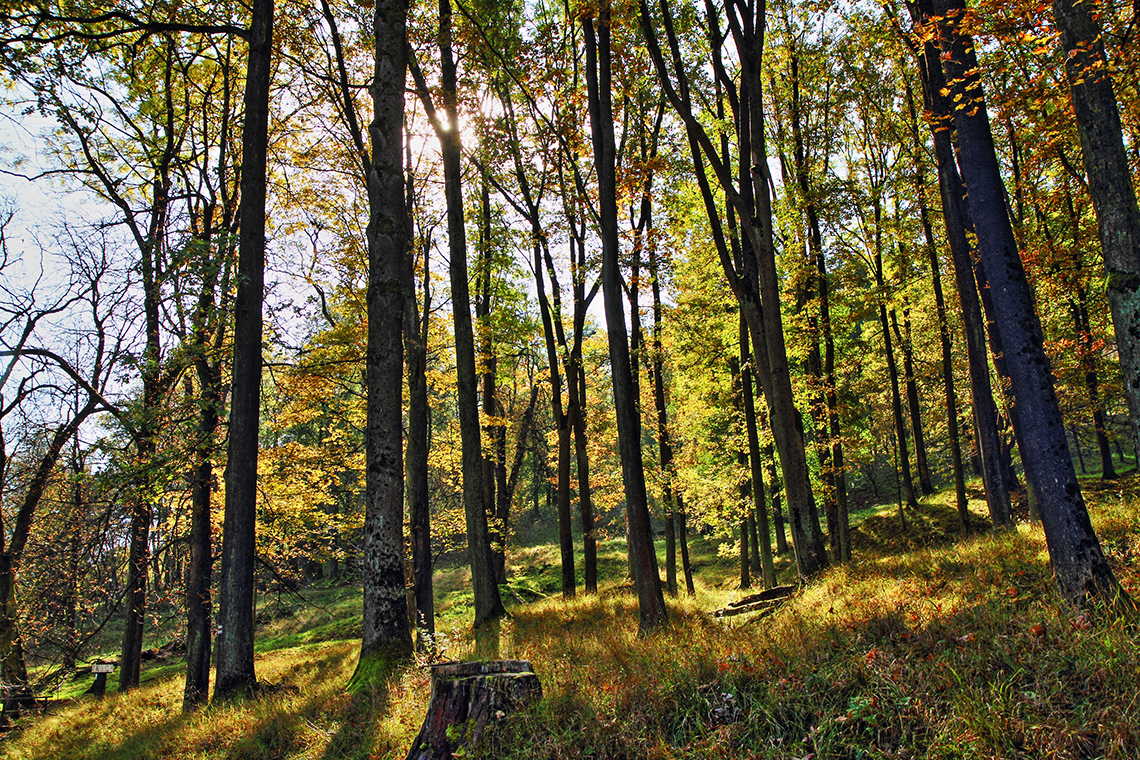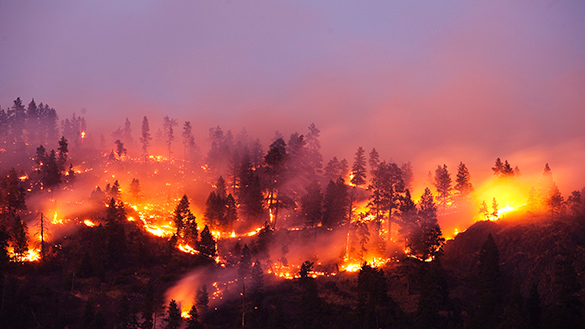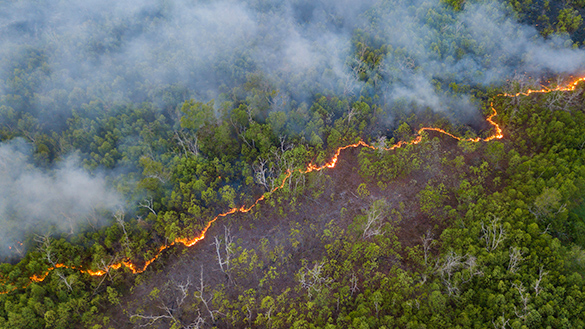Minds On
A forest ecosystem

Forest ecosystems consist of both biotic and abiotic factors.
Press the following tabs to learn more about these terms.
Biotic factors are living things within an ecosystem.
Abiotic factors are non-living components.
Brainstorm
Brainstorm
Let’s brainstorm the following:
- Can you think of any biotic and abiotic factors within a forest ecosystem?
- How do you think these factors would be affected by a forest fire?
Brainstorm and record a list of your ideas in a notebook or another method of your choice.
When you’re ready, press the ‘Answer’ button to reveal possible biotic and abiotic factors.
| Biotic (living things) | Abiotic (non-living things) |
|---|---|
|
Plants |
Rock |
|
Protists (small organisms) |
Soil |
|
Animals |
Air |
|
Fungus |
Minerals |
|
Bacteria |
Light |
Action
Ontario connection
This learning activity highlights people, places, or innovations that relate directly to the province of Ontario. Enjoy the exploration!

Climate change in forests
Ontario’s forests are important to climate change. Forests reduce the buildup of greenhouse gases to reduce climate change by converting carbon dioxide from the atmosphere into organic compounds. The amount of carbon stored in Ontario’s forests and wood products is very important to the carbon cycle.

On a global scale, forests help to maintain Earth’s carbon balance and help lessen the impacts of climate change. The carbon absorbed by forests reduces the rate at which carbon collects in the atmosphere which then reduces the rate at which climate change occurs.
- A forest is considered a carbon source when it absorbs less carbon than it releases. Forest carbon is released when trees burn or decay due to old age or wildfire.
- A forest is considered a carbon sink if it absorbs more carbon from the atmosphere than it releases.
Scientific evidence suggests that climate change could impact the province’s natural resources, including forests, causing:
- changes in forest growth due to climate warming and changes in precipitation
- changes where tree species can grow
- extreme weather events, wildfires, and other natural disturbances
Sustainable forests
Managing Ontario’s forests sustainably can help address the effects of climate change.
Check out the following strategies help reduce the effects of climate change on Ontario forests:
- reducing emissions and increasing carbon storage in forests and harvested wood products
- using innovative strategies to help forests adapt to climate change
Investigate
Investigate
Let’s investigate the following image to learn more about sustainable forest management and carbon storage.

Source: Ontario Ministry of Mines, Ministry of Northern Development, and Ministry of Natural Resources and Forestry
This image is a flow chart that outlines the sustainable forest management and carbon storage in Ontario. Carbon is emitted from cars and factories and this goes into the atmosphere. This is represented with an arrow that goes from a factory and a car to a cloud at the top of the flow chart. The arrow then travels down to an image of reforestation and sustainable forest management practices that ensure the carbon cycle continues. There is also an image of trees here and a message that growing forests absorb carbon and release oxygen. There is also a message that states old forests release their stored carbon slowly as they decay or rapidly through wildfires. The arrow goes up into the cloud and alongside the carbon being emitted by the factories and cars along with the statement that decaying forests release carbon.
After exploring the previous image, reflect on the following questions.
- What is sustainable forest management?
- How can these strategies help enhance a positive impact on the environment?
- planting trees
- using renewable bioenergy
You may use the diagram to guide your responses.
Record your ideas in a notebook or another method of your choice.
When you’re ready, press ‘Let’s Check!’ to access a possible response.
Sustainable forest management is regulating the forest resources to meet the needs of society and industry, but also preserving the health and growth of the forest for the present and the future.
Succession
Forests are composed of dynamic webs of organisms that change over time. This process of change is called succession.
Press the following tabs to access two various types of succession.
Primary succession is a community of plants and animals that develops where none existed before (e.g., newly formed volcanic rocks, rocks newly exposed by erosion or glaciers).

A chart showing primary succession. It shows the progress from rock to trees over hundreds of years. The process starts with bare rock, then lichens, then small annual plants and lichens, and then perennial herbs and grasses. These are all known as the pioneer stages. After this, grass, shrubs and shade-intolerant trees develop. This is known as the intermediate stage. Finally, on the far right side of the chart is shade-intolerant trees. This is known as the climax community.
Secondary succession is a community of organisms that replaces an original community that was destroyed by a natural or human-related event (e.g., a hurricane, forest fire, volcano).

A chart showing secondary succession. It shows the progress from fire to regrown forest over a span of years. The process starts with fire. After 1 to 2 years, annual plants start to grow. After 3 to 4 years, grasses and perennials grow. These are known as pioneer species. Over the next 5 to 150 years, grasses, shrubs, pines, young oaks and hickory grow. These are known as intermediate species. After 150 years, mature oak and hickory forest grows. This is known as climax community.
Secondary succession and forest fires

When a forest fire occurs, many plants and animals disappear, but the land itself is not uninhabitable. The soil itself may still have nutrients and seeds that will grow again but it will take some time.
As we recall, there is a progression of events or stages that happen after a forest fire.
These events include:
- Stage 1: The event (the forest fire) stops, and the destruction ends.
- Stage 2: The soil remains.
- Stage 3: Time goes by.
- Stage 4: Regrowth then begins.
- Stage 5: Fast-growing plants and trees begin to grow.
- Stage 6: Slow-grow plants and trees now begin to grow.
- Stage 7: The area is fully populated again.
Pause and Reflect
Pause and reflect
What is one similarity and one difference between primary and secondary succession?
You may refer to the previously explored images and descriptions to guide your response.
Record your ideas in a notebook or another method of your choice.
Press ‘Let’s Check!’ to access a possible response.
Similarity is the growth of new plants and animals. Difference is that primary succession occurs where there was not growth before, and secondary succession is a replacement of growth.
Learning check!
Let’s order the progression of events after a forest fire.
Forest fires

Forest fires can be very damaging, but they also have benefits.
Press the following tabs to access the benefits of forest fires.
Fire removes low-growing underbrush and cleans the forest floor of debris, to open it up to sunlight and nourish the soil.
Fire cleans wild lands of heavy brush, leaving room for new plant species that provide a habitat for wildlife.
Fire kills diseases and insects that prey on trees and provides valuable nutrients that enrich the soil.
Change is important to a healthy forest. Some species of trees and plants are actually fire dependent. They must have fire every 3 to 25 years in order for life to continue.
Did You Know?
Did you know?
Forest fires have a positive impact.

Controlled use of wildland fires for positive environmental effects is common around the world. Some burns are planned extensively and performed with tight parameters to promote ecological health and prevent larger, more damaging, uncontrolled fires.
Many ecosystems benefit from periodic fires because they clear out dead organic material. Dead or decaying plants begin to build up on the ground, which prevents animals and other plants from accessing the soil. With a planned fire, this is removed, allowing all animals and plants to access the healthy parts of the ecosystem.
Some plants require fire to move along in their life cycle. For example, a pine tree’s seeds are enclosed in pinecones, that can easily be released during a fire. Animals are often able to avoid fires by burrowing in the ground or fleeing to safety and a planned burn might get rid of invasive species.
Unplanned forest fires

A wildfire can be defined as any type of uncontrolled fire that is spreading across wildland, including forests. Wildfires happen either because of human activity or a natural event, such as a lightning strike. Sometimes, if vegetation is very dry, it can spontaneously ignite. Several heat and drought fueled wildfires have been linked to climate change.
If we don’t break the warming cycle, it is likely these fires will be more frequent and worsen over the coming years. The hotter our climate gets, the more susceptible we are to forest fires.
What do you think?
Reflect on the following question:
What is the difference between a planned fire and an unplanned fire?
Record your ideas in a notebook or another method of your choice.
Reading Time
Case study: Oak Savanna

Oak Savanna
Oak Savanna is one of the unique and diverse habitats in Ontario’s Pinery Provincial Park. Early habitants of the area avoided agricultural development (farming) because the soil was very sandy. Instead, a sawmill was constructed.
In the 1980s, it was realized how fragile the Oak Savanna ecosystem was and it was kept stable by periodic forest fires. Through deliberate management techniques, such as planned burnings and pine cuttings, Pinery Provincial Park has restored its Oak Savanna’s ecosystems.
Consolidation
Review your learning

For this activity, sort the examples as primary succession or secondary succession.
Making connections
For this section, you may choose to do one of the following activities, or both if you’d like!
Press the following tabs to access two activities.
Purposeful forest fires
Humans sometimes create purposeful forest fires in an area.
What are the costs and benefits of these fires? You may refer to what we have learnt throughout this learning activity in your response.
Overall are there more costs or benefits?
Record your ideas in a notebook or another method of your choice.
Secondary succession following a forest fire
Create a flowchart that shares how secondary succession flows from beginning to end after a forest fire has ended. Be sure to include images, text, etc., in your flowchart.
You may create your flowchart in print, digitally, or using another method of your choice.
Reflection
As you read the following descriptions, select the one that best describes your current understanding of the learning in this activity. Press the corresponding button once you have made your choice.
I feel…
Now, expand on your ideas by recording your thoughts using a voice recorder, speech-to-text, or writing tool.
When you review your notes on this learning activity later, reflect on whether you would select a different description based on your further review of the material in this learning activity.
Press ‘Discover More’ to extend your skills.
Discover MoreYou will now access the article “Climate change means more forest fires in Ontario. Here’s why.”

Press tvo today to access Climate change means more forest fires in Ontario. Here’s why.
TVO dot org (Opens in a new tab)After exploring the article, reflect on the following question:
- Why has Canada experienced an increase in forest fires?
Record your ideas in a notebook or another method of your choice.